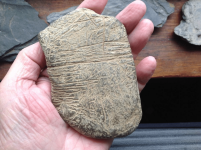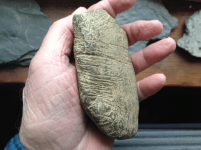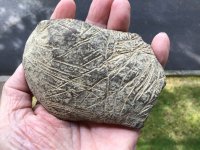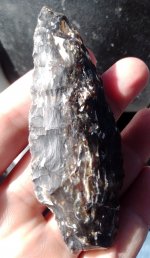jamus peek
Sr. Member
- May 13, 2014
- 373
- 333
- Primary Interest:
- All Treasure Hunting
Upvote
0
View attachment 1837519
View attachment 1837516
View attachment 1837517
View attachment 1837518
Those are sedimentary stones...layered sediments..compressed under extreme pressure...folded...compressed again under extreme pressure....eroded in odd angles.
I’m not saying the pieces you have shown, especially one of the later ones, were not handled...but the lines are due to the formation of the stone.
Athough not sedimentary stone..check out the bluff face of the old man on the mountain I posted in the other thread...clearly can see rolling and folding that occurred under extreme heat...
I have heard of sinew stone but just from my experience with sinew and I have handled 1,000 of pieces, is once it's dried all you have to do is bend an work it back and forth an it will come apart in threads
So JMO I see no reason to have a stone to work it. JMO from years of working with it.
That’s OK, I’m no expert. Just my opinion based on all the rocks I’ve found laying around in my lifetime.
Just sitting around listening to the scanner traffic about the rioting.



Another view of the example jamus gifted me. These are man-made incised lines...
View attachment 1837610
I have not read this entire thread as yet. Nor viewed the many illustrations. But, I just want to make an observation: I have enjoyed a long correspondence with jamus regarding the very many incised rocks he has collected. He knew I had a long standing interest, both in portable petroglyphs, and randomly incised rocks. Recall, for instance, the curious incised rocks from the Paleo era Gault site, in Texas. I can say that while some may be natural, many of the numerous photos jamus sent me showed rocks with man-made incised lines. I can’t interpret them, some must have been functional in sharpening activity, others probably not. But he sure has found a lot!
And jamus, let me take the opportunity again, to thank you for your kind gift. You know I like and appreciate it very much!

Another view of the example jamus gifted me. These are man-made incised lines...
View attachment 1837610
I have not read this entire thread as yet. Nor viewed the many illustrations. But, I just want to make an observation: I have enjoyed a long correspondence with jamus regarding the very many incised rocks he has collected. He knew I had a long standing interest, both in portable petroglyphs, and randomly incised rocks. Recall, for instance, the curious incised rocks from the Paleo era Gault site, in Texas. I can say that while some may be natural, many of the numerous photos jamus sent me showed rocks with man-made incised lines. I can’t interpret them, some must have been functional in sharpening activity, others probably not. But he sure has found a lot!
And jamus, let me take the opportunity again, to thank you for your kind gift. You know I like and appreciate it very much!
Its very clear that the lines on that piece have been incised, but I really don't believe that on the first one.
You are very welcome Charlie! Thank you very much for the gifts I received from you. To be honest if it wasn't for the Incised stones you had shared I probably never would of looked for them.
Also thanks for the encouragement to find a point. I believe I may have found a nice one. Possibly a Western Stemmed Point. My thoughts were Parman or Lind coulee. I know I'm probably dreaming though. I'll start a thread to see if I can get an ID.
View attachment 1837702
I have heard of sinew stone but just from my experience with sinew and I have handled 1,000 of pieces, is once it's dried all you have to do is bend an work it back and forth an it will come apart in threads
So JMO I see no reason to have a stone to work it. JMO from years of working with it.